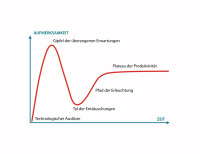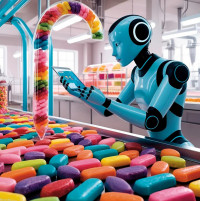The confectionery industry is facing many challenges, such as price increases for cocoa, a raw material shortage for hazelnuts, the EU packaging regulation, and the demand for new products and raw materials such as vegan chocolate or locally produced cocoa. At the same time, technological developments offer great opportunities to overcome these hurdles. This article discusses how AI can be used and what challenges need to be overcome to realise its full potential.
By Prof. Dr. Christine Borsum Chair of Process Engine
Two key problems are the price increase for cocoa and the shortage of raw materials like hazelnuts, which are affecting the production of many confectionery products. AI could help to reduce production costs and increase yields through optimised cultivation techniques and more precise weather forecasts. Another problem is packaging, a key issue in the sustainability debate. The EU packaging regulation is putting pressure on food manufacturers to develop more sustainable packaging. AI methods such as reinforcement learning could provide support here to ensure robust production processes even with recyclable materials. AI algorithms could also be used to predict the shelf life of food in new packaging and to monitor critical production steps in order to detect errors at an early stage and improve product quality.
We are currently in the exaggerated expectations stage of the hype cycle. AI is often seen as a panacea, which leads to disappointment when the technology does not deliver the hoped for results. A look at the hype cycle shows that initial exuberance is followed by a phase of disappointment. However, the real breakthrough comes when the technology is mature and offers concrete solutions. In the confectionery industry, too, we need to move from the disappointment phase to a productive phase by working together across disciplines.
A key psychological obstacle to the introduction of AI is the self-perception of specialists, who rely on their own expertise and often consider other disciplines to be less relevant. Communication between experts from different disciplines is also hampered by different “languages”, as everyone is trapped in their own jargon. These barriers are reinforced by academic structures that often hinder interdisciplinary collaboration. Funding, such as that from the German Research Foundation (DFG), is often only awarded to projects from one discipline, which makes it difficult to develop innovative solutions.
Another problem is that academic training is highly specialised and leaves little room for interdisciplinary work. Specialists from different fields, such as food technology or computer science, often have different perspectives and are difficult to win over for interdisciplinary collaboration. However, interdisciplinary work requires not only communication skills, but also curiosity and interest in other specialist areas.
One solution could be to train “bridge builders” who can connect several disciplines. These professionals must not only be experts in their own field, but also develop an understanding of other disciplines. They could act as a link between computer science, food technology and other fields and drive the implementation of AI in the confectionery industry. In computer science, it is easier for career changers to continue their education. Platforms such as Udemy and YouTube offer flexible training opportunities, and many universities offer free lectures on AI topics. In addition, more and more platforms are emerging that make it possible to develop AI models without in-depth programming knowledge.
There are already many successful examples of interdisciplinary collaboration. The basics of AI are already taught in medical studies, and medical informatics forms an interface between medicine and computer science. Mechanical engineers at the University of Applied Sciences Kempten learn programming languages such as Python in order to come into contact with AI as well as physical simulations during their Bachelor Degree. Another example is the AIDAHO project at the University of Hohenheim, which offers students interdisciplinary training in AI. Universities around the world are also making new appointments to professorships that emphasise digital skills and interdisciplinary collaboration. The 2024 Nobel Prize in Physics and Chemistry for interdisciplinary work with AI shows the value of combining AI with different scientific disciplines.
The confectionery industry has the opportunity to use AI to overcome many of its current challenges, such as the price increase for cocoa, the shortage of raw materials like hazelnuts and compliance with EU packaging regulations. However, success depends not only on the technology, but on the ability of professionals to think and work in an interdisciplinary way. It is crucial to overcome the existing barriers in mindset and academic structures in order to train “bridge builders” who can connect different disciplines. This is the only way the confectionery industry can benefit from the potential of AI and remain fit for the future. In order to make progress in the hype cycle, we need to leave behind exaggerated expectations and fears and develop practical solutions this can only be achieved through increased cooperation between the disciplines of food technology and computer science.
https://www.hs-kempten.de/fakultaet-maschinenbau/ueber-uns/personen-detailansicht/christine-borsum





